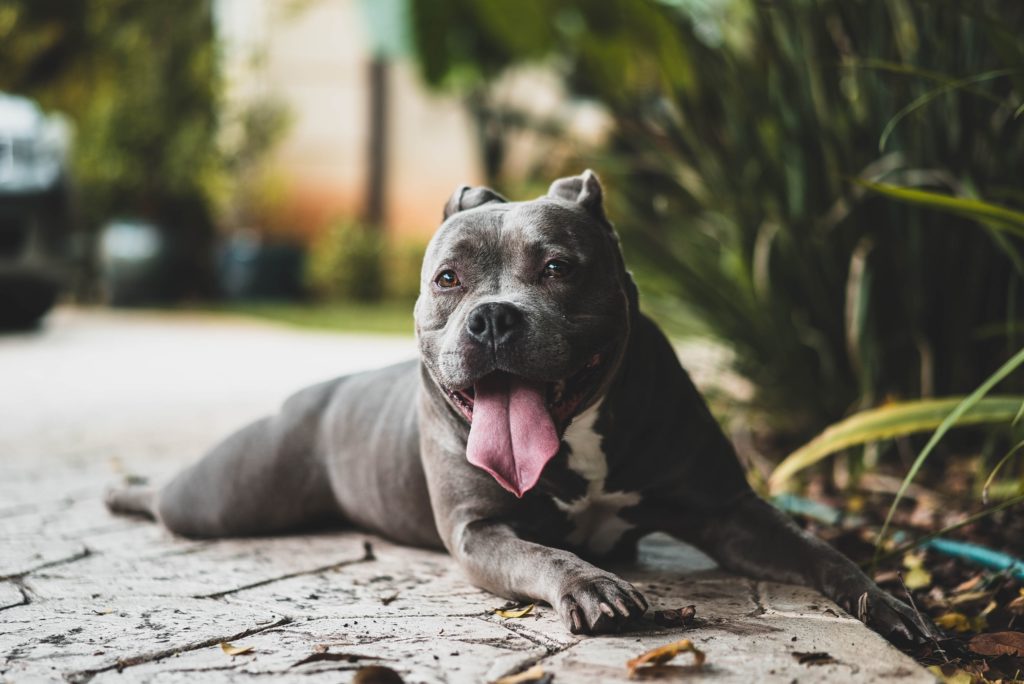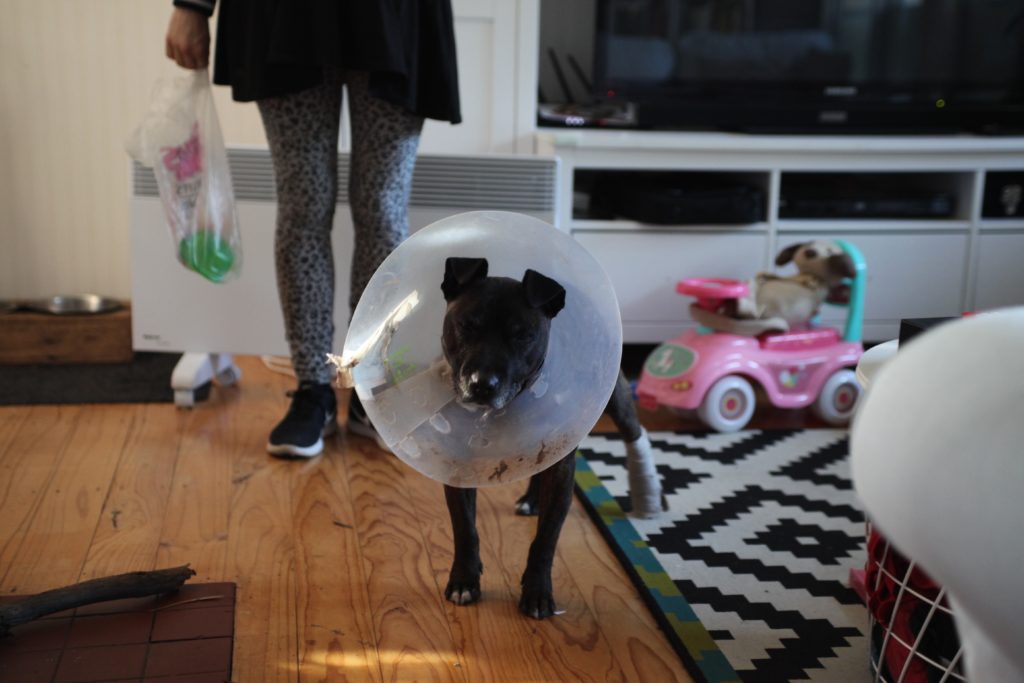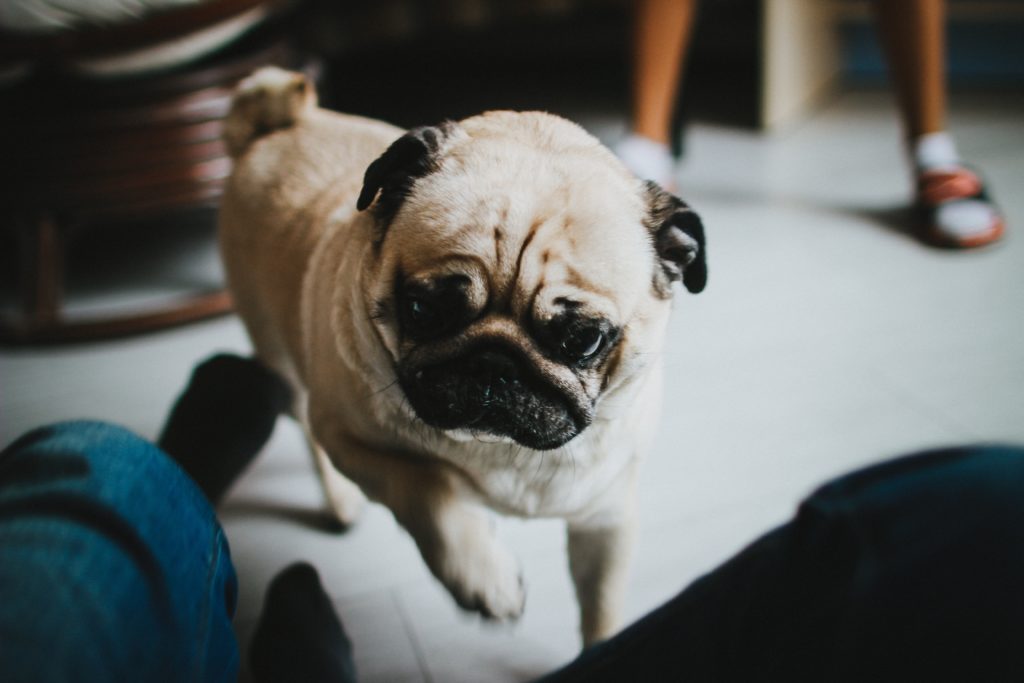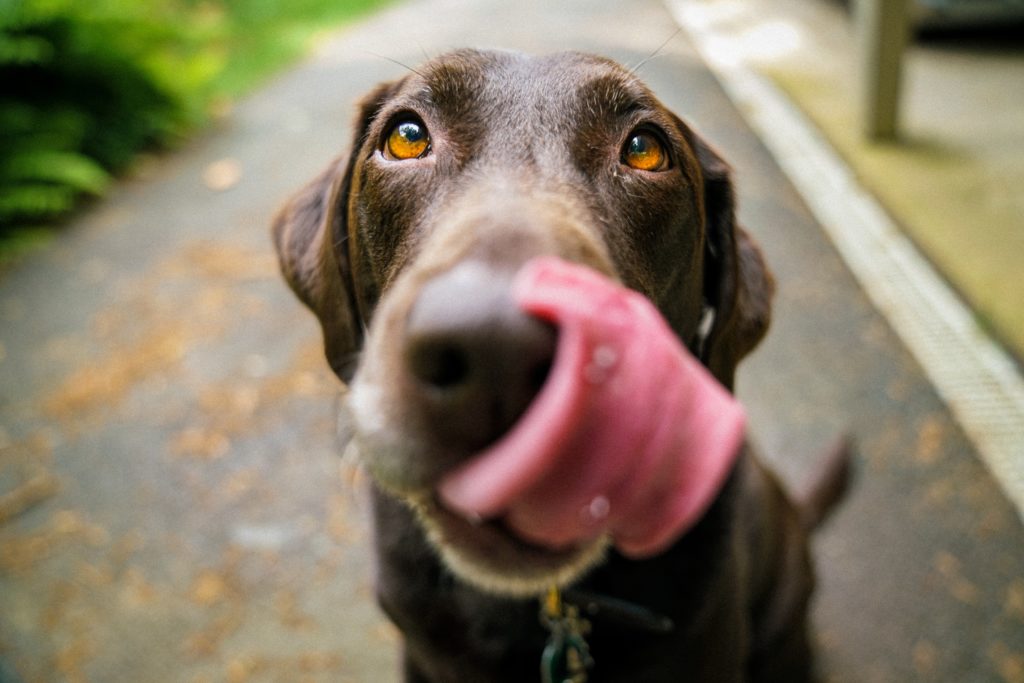Dogs may lick themselves for grooming purposes, to alleviate pain, or to try and calm irritation from some kind of injury or allergy. Licking an injury is a natural behavior, however, sometimes it can do more harm than good, especially if the wound is something like a surgical incision. Excessive licking hinders your dog’s ability to heal properly and can even kill the living tissue located around the incision site. Since full healing is the goal, it makes sense to limit your dog’s ability to lick his wounds as much as you are able.
If you have a dog licking a wound and you don’t know what to do, follow these tips in this blog post or consult with your veterinarian for further assistance.
Why Do Dogs Lick Wounds?
 So why is your dog licking a wound? Though it can be difficult to understand, licking can be a soothing behavior for dogs. This behavior is a way for your dog to alleviate pain and keep himself calm. Some professionals even make a case that licking an injury can help prevent infections and keep the wound sanitized. While this is not completely wrong, if the licking is excessive, it can cause more problems than it solves.
So why is your dog licking a wound? Though it can be difficult to understand, licking can be a soothing behavior for dogs. This behavior is a way for your dog to alleviate pain and keep himself calm. Some professionals even make a case that licking an injury can help prevent infections and keep the wound sanitized. While this is not completely wrong, if the licking is excessive, it can cause more problems than it solves.
Does Saliva Have Healing Properties?
With moderate licking, dog saliva may be helpful. Dog saliva contains enzymes which helps to promote healing and works to break down the cell wall of bacteria that cause infections. Moderate licking of your dog’s wound can also remove dirt and debris that may be making the injury worse, as well as deliver antiviral and antibacterial compounds to the wound.
Though it may seem more myth than fact, there is actually scientific evidence to back up these claims. It’s even thought that saliva has a bactericidal effect against bacteria like E. Coli. Dog saliva also has growth factors, protease inhibitors, and opiorphin which acts as a pain reliever. Not to mention, there are nitrate compounds contained in saliva that help inhibit bacterial growth by breaking down into nitrous oxide and stimulating the healing process. However, all of these effects are considered to be mild and they may not outweigh the negatives that can result from too much licking.
Dangers of Letting Your Dog Lick His Wounds
Unfortunately, letting your dog lick his wounds can be detrimental to his health. This is especially true if your dog had surgery or stitches. The goal of stitches is to keep a wound closed long enough for it to heal properly. Overzealous licking can quickly turn into chewing and biting. Before you know it, any stitches that are in your dog’s way will get pulled out and the wound will be reopened.
Not only is reopening the wound a problem, but excessive licking can cause additional canine pain and irritation. Your dog’s wound could become infected, the very thing you’re trying to prevent, and your dog could also accidentally cause self-mutilation that will be permanent. Sometimes a dog can lick a wound so much that he kills the healthy tissue, leaving dead tissue in its place. This tissue may look grey and secrete fluid with a foul odor.
The destruction of stitches, the killing of healthy tissue, and the reopening of a wound can all result in extra visits to the vet and additional surgeries. This means extra time and money invested while slowing down the entire healing process for your dog.
Prevent Your Dog from Licking HIs Wounds
There are several ways to prevent a dog from licking his wounds too much. These methods can range from making your dog wear special collars, to using behavior modification techniques and distractions.
Using Special Collars
 In many cases of wound care, your vet will send you home with one of those hideous plastic Elizabethan collars. You know the kind. They’re not only bulky, they’re often too big and have to be modified or adjusted to fit your dog. They can also be a pain in the butt as your dog tries to navigate normal everyday life around your home. Plus, if the collar is too large (and it usually is), it can scare your dog and severely limit his ability to see properly. It’s a sure bet your dog will not be thrilled to be stuffed into one of these collars, although they can be effective.
In many cases of wound care, your vet will send you home with one of those hideous plastic Elizabethan collars. You know the kind. They’re not only bulky, they’re often too big and have to be modified or adjusted to fit your dog. They can also be a pain in the butt as your dog tries to navigate normal everyday life around your home. Plus, if the collar is too large (and it usually is), it can scare your dog and severely limit his ability to see properly. It’s a sure bet your dog will not be thrilled to be stuffed into one of these collars, although they can be effective.
Despite the problems with them, if an Elizabethan collar is the route you want to go, try to find one that is transparent so your dog can see through it. You will also want to find one that is an appropriate size for your dog. If it’s too big, it will just make him miserable. There are also alternatives to the traditional Elizabethan collar, such as those made from more comfy materials that are a lot less bulky and unwieldy than their plastic cone counterparts. There are also inflatable donut-style collars that can be effective. The trick with these is they have to be big enough while fitting properly in order to keep your dog from reaching and licking his wounds.
Create a Barrier
Sometimes, using a bandage can be effective, provided your dog gets used to the bandage. This is easier said than done. How your dog responds to wearing a bandage will largely depend on his temperament. Breed can also play a factor. Some breeds are more finicky and prone to chewing things than others, especially if that thing is on your dog’s body and he wants it off. Some dogs will simply chew through their bandage to get to their wound, no matter how many times you replace it. This defeats the purpose and makes bandages completely ineffective.
Bandages are also not always ideal depending on what part of the body the wound is located. Bandaging also requires frequent changing so that they stay clean and dry. You also have to be careful with bandages and make sure you are using only creams and ointments on your dog’s wound that are recommended by your vet. If you use something you shouldn’t and your dog eats through his bandage to the ointment beneath it, he could ingest something that will make him sick.
In some cases, you can use special boots to create a barrier that may work better. Your dog can wear a boot either on its own or over the top of his bandage. However, boots are only suitable for leg or dog paw pad injuries and the same rules apply as bandages when it comes to creams or ointments. If your dog gets past the boot to whatever you’ve put on his injury, he will end up ingesting it, so you have to make sure you are using creams and ointments that are safe for dogs, whether he wears a boot or a bandage, or both.
Speaking of using both, you have to know ahead of time if you’re going to be using a boot with a bandage beneath it, because that will affect the size of the boot you should purchase. You want your dog’s boot to be slightly bigger than his foot, so that it stays on but isn’t too tight for your dog to wear. The nice thing about boots is they are fairly easy to pull on and off and can work well if your dog’s wound is on his leg or paw. If the wound is elsewhere, like his tummy, a boot won’t be helpful.
Note that some dogs will hate a boot as much as they hate the cone collars. It basically makes it a case of picking one evil over another. You can’t simply ignore your dog and hope for the best, because there is no question that he will resort to licking given half a chance. So, you have to decide on something that works for you and your dog. You may have to go through a bit of trial and error to find that something, but that’s much better than paying out of the nose for unnecessary vet bills, or risking your dog possibly mutilating himself permanently.
Create Distractions
In some cases, creating a distraction for your dog may be the best way to keep him from licking his wounds. When you distract your dog and pull his mind away from his wound, he will forget about it (at least temporarily) and the temptation to lick will be greatly reduced.
 You can try distracting your dog by teaching him a new trick, one that’s not too strenuous or will endanger his wound. You can try distracting your dog with a new toy to play with. You can distract him with a bone or give him one of those puzzle treats that he really has to work for. Extra exercise as long as it doesn’t cause too much stress on his wound can also be an effective distraction tactic.
You can try distracting your dog by teaching him a new trick, one that’s not too strenuous or will endanger his wound. You can try distracting your dog with a new toy to play with. You can distract him with a bone or give him one of those puzzle treats that he really has to work for. Extra exercise as long as it doesn’t cause too much stress on his wound can also be an effective distraction tactic.
Some dogs really enjoy treats like ice cubes made with meat broth. Many dogs like ice cubes even without meat broth but add that little extra flavoring and you’ve got both a treat and a distraction rolled into one. Hopefully it will keep him busy for a while! Note that you should probably only give this to him when he’s outside, otherwise you’ll have quite a mess on your hands.
Some owners find success using strips or sprays designed to discourage licking. These can work well with some dogs and not so well with others. Strips and sprays work by discouraging your dog from licking due to the terrible flavor, like bitter apple. Just be sure to look for products made with natural ingredients so that you don’t have any yucky side effects or any canine allergic reactions from additives.
Unfortunately, the biggest problem with using products like this is they don’t always deter a determined dog. Some dogs will continue to lick regardless of what something tastes like. It’s like he doesn’t even notice the disgusting flavor. If this is your dog, don’t waste your time. You will need to try one of the other methods to discourage your dog from licking his wounds or come up with some other creative solution.
Whatever you do, don’t just ignore your dog or lock him in his kennel and expect him to leave his wound alone. That’s just not going to happen. The minute a dog becomes bored, he will begin licking that wound merely because it gives him something to do. A bored dog can make quick work of ripping out stitches and reopening an incision.
Note that in severe cases, if you absolutely cannot get your dog to stop licking his wound obsessively, you may need to see your vet so they can prescribe possible medications to help your dog curb the compulsive behavior. If you don’t want to put your dog on medication, that’s okay too. Your vet may have some ideas for natural solutions or offer other creative ways to distract your dog so he can heal properly.
Sources:
Burke, Anna. “Do Dogs Need to Lick Their Wounds? – Dog Myths Debunked.” American Kennel Club, 27 Apr. 2018, www.akc.org/expert-advice/health/dog-myths-debunked-licking-wounds/.
“How to Stop Dogs from Licking Their Wounds.” Blue Cross, www.bluecross.org.uk/pet-advice/how-stop-dogs-licking-their-wounds.
“Why Do Dogs Lick Their Wounds?” Assisi Animal Health, www.assisianimalhealth.com/blog/2013/08/why-do-dogs-lick-their-wounds/.
“Helpful Hint – Four Ways You Can Stop Your Dog Licking Their Wounds.” Manuka Vet, 14 Nov. 2017, www.manukavet.com/blog/post/22700/Helpful-hint-Four-ways-you-can-stop-your-dog-licking-their-wounds/.




